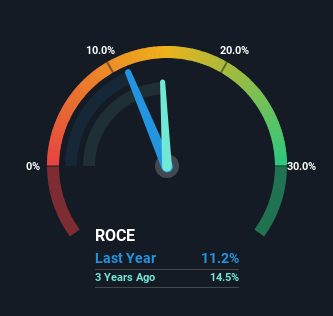
What trends should we look for it we want to identify stocks that can multiply in value over the long term? Typically, we'll want to notice a trend of growing return on capital employed (ROCE) and alongside that, an expanding base of capital employed. Put simply, these types of businesses are compounding machines, meaning they are continually reinvesting their earnings at ever-higher rates of return. Speaking of which, we noticed some great changes in Boer Power Holdings' (HKG:1685) returns on capital, so let's have a look.
What Is Return On Capital Employed (ROCE)?
For those who don't know, ROCE is a measure of a company's yearly pre-tax profit (its return), relative to the capital employed in the business. To calculate this metric for Boer Power Holdings, this is the formula:
Return on Capital Employed = Earnings Before Interest and Tax (EBIT) ÷ (Total Assets - Current Liabilities)
0.11 = CN¥48m ÷ (CN¥1.4b - CN¥929m) (Based on the trailing twelve months to June 2024).
Thus, Boer Power Holdings has an ROCE of 11%. On its own, that's a standard return, however it's much better than the 6.3% generated by the Electrical industry.
See our latest analysis for Boer Power Holdings

Historical performance is a great place to start when researching a stock so above you can see the gauge for Boer Power Holdings' ROCE against it's prior returns. If you'd like to look at how Boer Power Holdings has performed in the past in other metrics, you can view this free graph of Boer Power Holdings' past earnings, revenue and cash flow.
What Does the ROCE Trend For Boer Power Holdings Tell Us?
We're delighted to see that Boer Power Holdings is reaping rewards from its investments and has now broken into profitability. The company was generating losses five years ago, but now it's turned around, earning 11% which is no doubt a relief for some early shareholders. Additionally, the business is utilizing 40% less capital than it was five years ago, and taken at face value, that can mean the company needs less funds at work to get a return. This could potentially mean that the company is selling some of its assets.
On a separate but related note, it's important to know that Boer Power Holdings has a current liabilities to total assets ratio of 69%, which we'd consider pretty high. This can bring about some risks because the company is basically operating with a rather large reliance on its suppliers or other sorts of short-term creditors. While it's not necessarily a bad thing, it can be beneficial if this ratio is lower.
In Conclusion...
In summary, it's great to see that Boer Power Holdings has been able to turn things around and earn higher returns on lower amounts of capital. Given the stock has declined 35% in the last five years, this could be a good investment if the valuation and other metrics are also appealing. That being the case, research into the company's current valuation metrics and future prospects seems fitting.
On a separate note, we've found 2 warning signs for Boer Power Holdings you'll probably want to know about.
For those who like to invest in solid companies, check out this free list of companies with solid balance sheets and high returns on equity.
Have feedback on this article? Concerned about the content? Get in touch with us directly. Alternatively, email editorial-team (at) simplywallst.com.
This article by Simply Wall St is general in nature. We provide commentary based on historical data and analyst forecasts only using an unbiased methodology and our articles are not intended to be financial advice. It does not constitute a recommendation to buy or sell any stock, and does not take account of your objectives, or your financial situation. We aim to bring you long-term focused analysis driven by fundamental data. Note that our analysis may not factor in the latest price-sensitive company announcements or qualitative material. Simply Wall St has no position in any stocks mentioned.